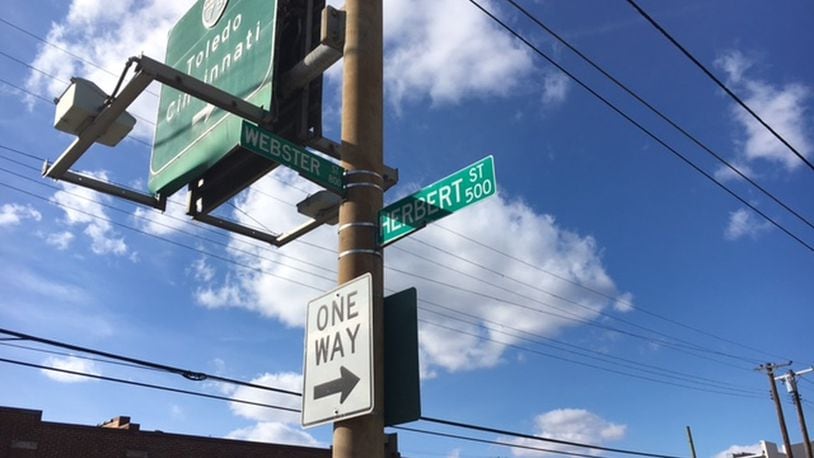The U.S. EPA identifies “Superfund” sites as areas contaminated by hazardous waste and considered candidates for cleanup.
The Behr plant’s environmental issues have been reported for years, by government and the media. Residents of the McCook Field Neighborhood learned of the issues as early as 2002, and Chrysler — which once operated the plant — set up monitoring wells around the neighborhood.
The locale — Northeastern Dayton — has neighborhoods with a blend of residential, commercial and industrial uses. The U.S. Environmental Protection Agency considers the area around Behr a “VOC (volatile organic compound) plume” site.
The plant has operated since the 1930s. Since the early 2000s, more than 200 homes in the area have had air monitoring systems installed at some point to detect vapor emissions within homes — and “extraction” systems to deal with whatever problems are found, said Jim Shoemaker, a hydro-geologist for the city of Dayton.
“Not all the homes have issues,” Shoemaker said.
Jerry Bowling III, president of the McCook Field Neighborhood Association and a Herbert Street resident, said residents have dealt with the situation in a variety of ways. Some have moved. Some have lived with the situation, as he does.
“You either live with it or move on,” he said. “That’s kind of the way it is.
But one consequence, as he sees it: Property values have been diminished, by about 10 to 20 percent, he said.
“That’s a big concern for some,” he said.
But life does go on. Bowling III said he lives with a monitoring system, and the system has never found problems in his home.
“We’re actually a pretty safe neighborhood,” he said.
The EPA has said it first interviewed residents about the site in 2009, with a “community involvement plan” developed in 2010. It also says it has conducted “extensive” groundwater sampling and soil sampling there.
An EPA spokeswoman said the agency is reviewing “draft remedial investigation and feasibility study reports.”
The EPA is working on a plan to cleanse the aquifer by bubbling air through it. The agency is also working on a way to extract vapor from the soil through underground vents installed above the water table, said the spokeswoman, Rachel Bassler.
Edmondson said she moved to the Dayton area in 2007 and was unaware of the issues. She found herself drawn to the Herbert Street house because it’s near Riverscape on the Great Miami River, and the house boasts a large urban garden, she said.
She learned of the environmental issues from neighbors when looking at the home and then contacted the EPA. Agency representatives asked her:”Are you in the home right now and are you currently pregnant?”
The questions shook her. “I just don’t want someone else to walk into this situation.”
Edmondson chose not to buy the house — but now she says she is out about $1,000 in inspection and other related costs.
Beryl Wilson, the Irongate Realtor who represents the home’s current owners, said she was similarly unaware of the area’s problems, learning of them during the selling process also from a neighbor.
“As soon as I knew something, I contacted the EPA,” Wilson said.
Wilson said she shared what she learned with the agent who represented Edmondson, a Sibcy Cline agent. A message seeking comment was left for that agent.
Robin Banas, sales manager for the Centerville Sibcy Cline office, told the Dayton Daily News that the firm is “on board” with Edmondson’s efforts to reclaim the money she has spent.
“We were just as surprised about that,” Banas said of the home’s environmental situation.
Future prospective homebuyers will be notified of the site’s status, Wilson said.
“I didn’t want anyone to buy the house and find out after the fact,” she said. “I want them to go in with their eyes open.”
Despite the area’s problems, Wilson said she sells “quite a few” homes in Old North and East Dayton.
A woman leaving a home in the 500 block of Herbert Friday afternoon declined to give her name, but said, “Our neighborhood is fine.”
The EPA says, in general, properties continue to be bought and sold on or near Superfund sites, and they have for years.
"Many Superfund sites have advantageous and desirable locations," the agency says on its web site. "Some federal, state, and local government agencies offer grants, loans, and tax incentives to encourage development and revitalization of" Superfund areas.
Karen O’Grady, president of the Dayton Area Board of Realtors, said it’s a Realtor’s job to notify any would-be buyer about anything that could negatively affect residents “that they know of.”
“Obviously, you have a fiduciary duty to know about the neighborhood and what’s going on,” O’Grady said.
About the Author
